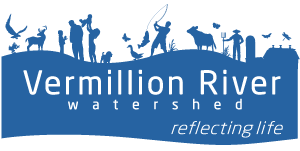What does drainage alteration mean?
Drainage alteration refers to a change in the natural course of water flow as it moves through the watershed. Drainage alteration may take the form of creating artificial drainage, pumping, diverting, obstructing (impounding or damming), channeling, or otherwise modifying the natural process of water movement through the landscape.
If drainage alteration is proposed, a permit must be obtained from the Local Government Unit (LGU) or the Vermillion River Watershed Joint Powers Organization (VRWJPO). The proposed drainage alteration is required to meet the criteria in the drainage alteration standard set by the VRWJPO.
When do requirements about drainage alteration apply?
Drainage alteration requirements apply when:
- An outlet is being proposed for a landlocked basin with a contributing area of 100 acres or more; or
- A drainage alteration is being proposed for a watercourse, public water, public water wetland, or wetlands that drain 640 acres or more.
What are the criteria in the standard?
For draining landlocked basins:
- Outlets are consistent with other portions of the VRWJPO Standards, as well as other local, state, and federal regulations.
- Analysis is completed of potential downstream, riparian, and habitat impacts of outlets; implementation results in no detrimental impact to property or natural resources.
- Runoff analysis for flows and water levels are based on a hydrograph method. A hydrograph is a graph showing changes in water flow or water level over time.
- The proposed post-installation hydrology (water distribution and movement) is consistent with peak runoff rate and volume controls.
- The outlet does not create adverse downstream flooding or water quality conditions, or affect stability of downstream water courses.
- The outlet maintains dead water storage, a volume with little to no current, in a basin or channel to the extent possible.
- Low floor elevations of structures are appropriately set back (consistent with Floodplain Alteration Standards).
- Development contributing runoff to a landlocked basin incorporates best management practices to reduce the runoff volume to the extent possible.
For proposed alteration of waterways, public waters, public waters wetlands, or wetlands:
- Alterations or diversions are consistent with other portions of the VRWJPO Standards, as well as other local, state, and federal regulations.
- Analysis of potential downstream, riparian, or habitat impacts of alterations or diversions are completed and predict no detrimental impacts.
- The proposal demonstrates a reasonable necessity for the alteration or diversion to improve or protect public health and safety or to improve or protect aquatic resources.
- Unnecessary injury to upstream or downstream lands is avoided.
- The alteration provides greater benefit (positive impacts of drainage, dam or diversion) than harm (costs) to lands affected by the alteration.
- The alteration benefits the natural hydrologic system by returning, restoring, or maintaining its natural capacities.
All drainage alteration proposals must provide for stable channels and outfalls that will not erode stream banks or shorelines.
Are there exceptions?
The LGU or VRWJPO may waive the evaluation of impacts if:
- The landowner can demonstrate that the proposed drainage alteration will cause no off-site impacts (erosion, sedimentation, flooding, or other damage); or
- The landowner provides proof of the consent of potentially impacted landowners through easements or other documentation (in a form acceptable to the LGU or VRWJPO).


